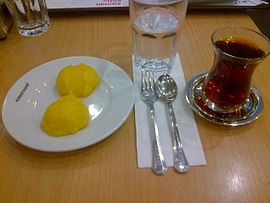This is an old revision of this page, as edited by Seraphim System (talk | contribs) at 03:05, 10 November 2018 (ce). The present address (URL) is a permanent link to this revision, which may differ significantly from the current revision.
Revision as of 03:05, 10 November 2018 by Seraphim System (talk | contribs) (ce)(diff) ← Previous revision | Latest revision (diff) | Newer revision → (diff) Hoşmerim and Turkish tea Hoşmerim and Turkish tea | |
| Course | Dessert |
|---|---|
| Place of origin | |
| Main ingredients | Semolina, cheese, sugar, milk, almond |
Höşmerim is a Turkish dessert popular in the Aegean, Marmara, Trakya and Central Anatolia regions of Turkey. It is sometimes called peynir helva or "cheese halva". It is generally consumed after a meal as a light dessert and may be topped with ice cream, honey or nuts.
Höşmerim has been served for 50–55 years as a commercial product in the markets and pastry shops. However, most of its manufacture occurs on a small scale. Recipes and methods may differ from one region to another. Traditional recipes include fresh unsalted cheese, semolina and powdered sugar. Commercially produced höşmerim may include cream, egg and riboflavin in addition to the traditional ingredients for the homemade varieties.
Etymology
According to the folk etymology, a soldier could not see his wife for a long time because of the war. When the war finished, man came to his village and saw his wife. His wife prepared Hoşmerim and asked her husband "Hoş mu erim?" meaning "Is it nice, my man?"
In reality, it comes from Persian xoş (sweet) + maram (kaymak).